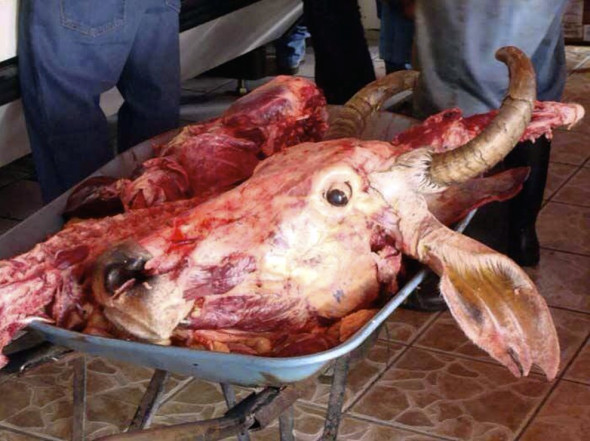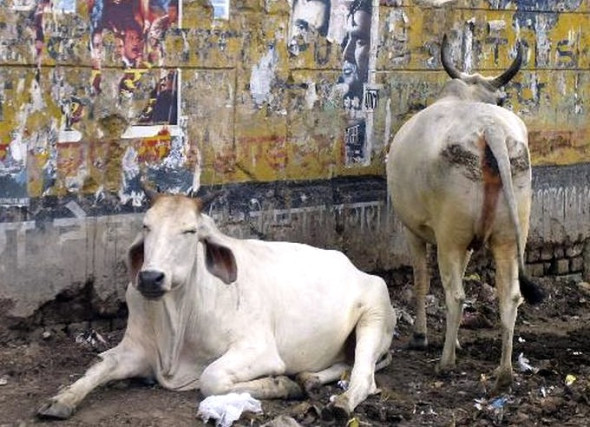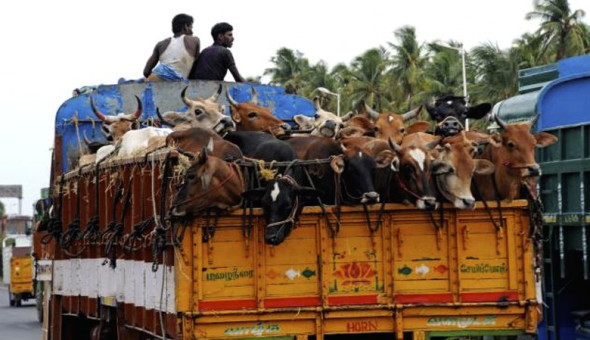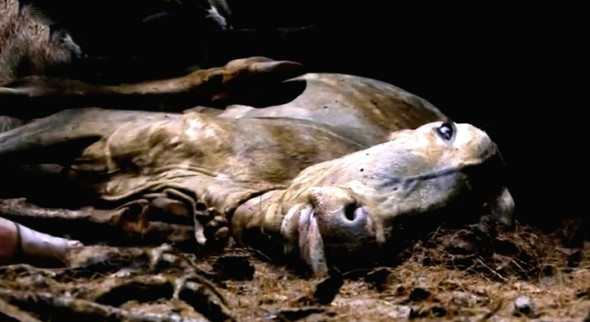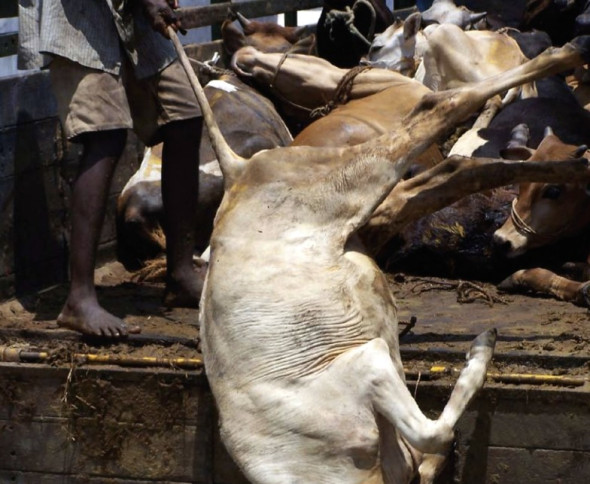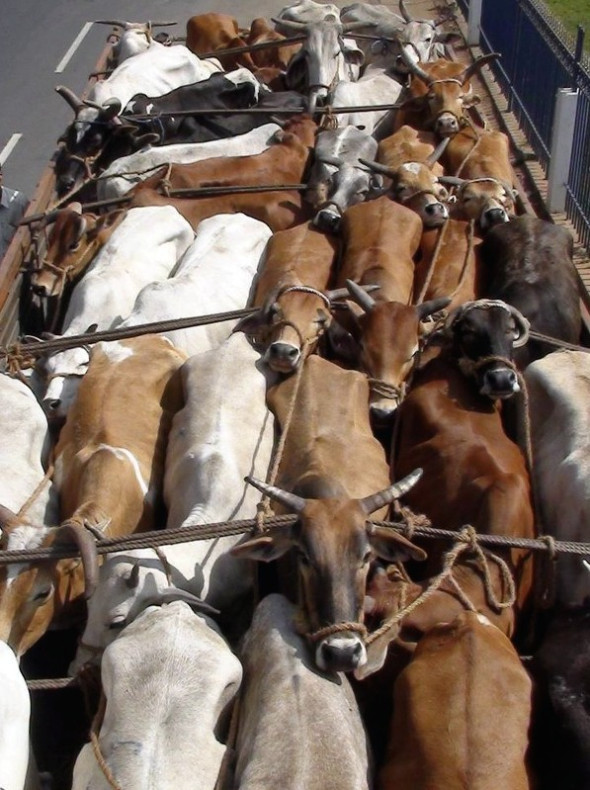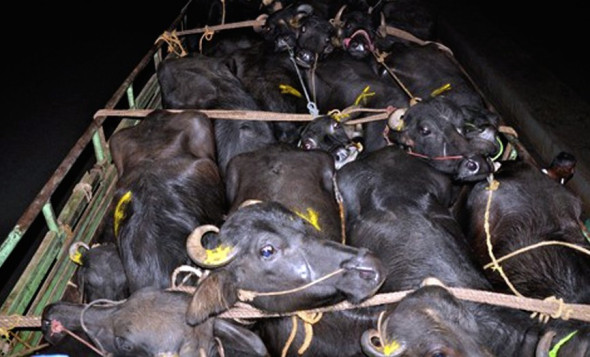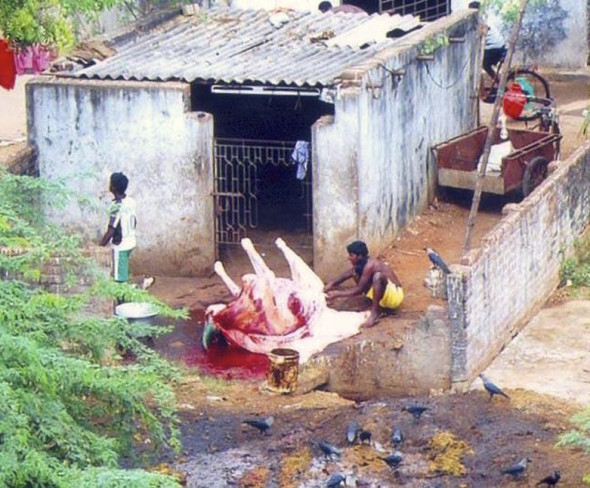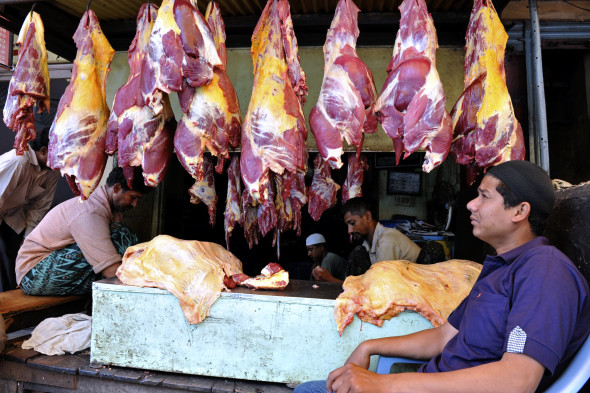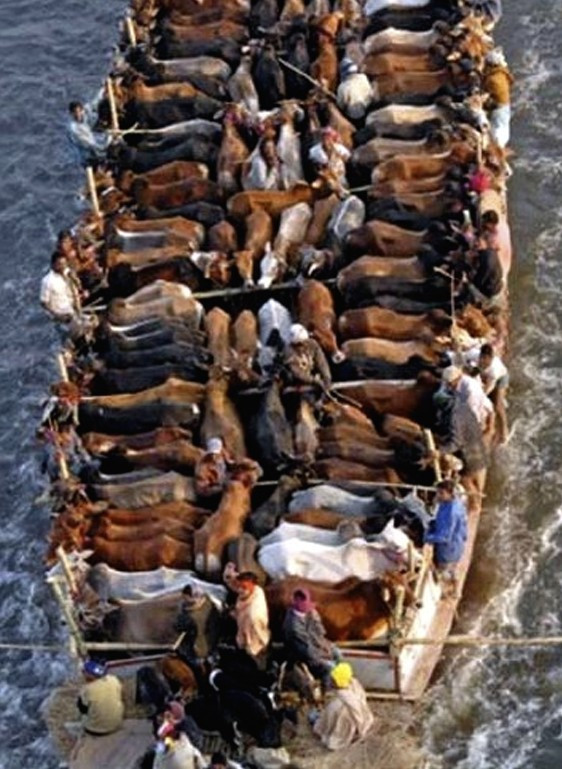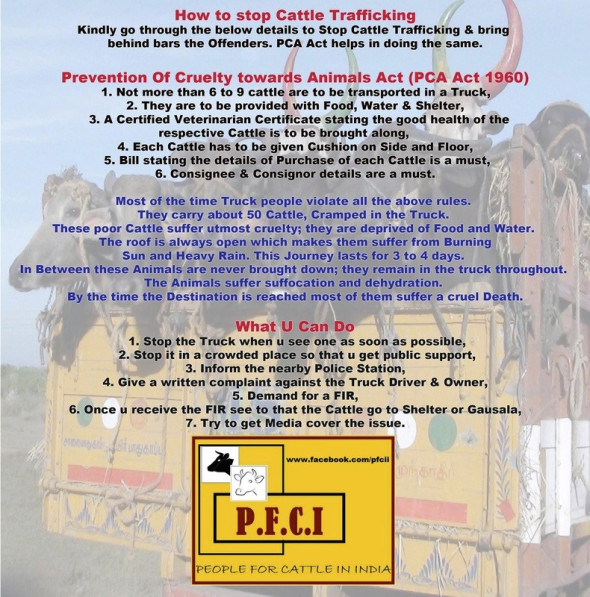India’s Illegal Sacred-Cattle Atrocities & Slaughterhouses
India’s gentle sacred cows and docile buffalo are treated appallingly in it’s illegal cattle trade where cows and buffalo are trafficked across the country to the only two states which allow cattle slaughter. Walking hundreds of miles, the animals collapse in exhaustion as traffickers push red chillies or tobacco into the animal’s eyes and anus and deliberately break the stricken animal’s tail. Those arriving at their destination on trucks, exhausted and collapsing, are forced to jump off high trucks causing them broken legs and pelvis as the weight of their body hits the ground. India’s cows and buffalo need their story to be heard.
Illegal cow slaughter in India comes down to an ethnic and religious struggle between Hindus and Muslims, which over time has resulted in riots and even deaths. Hindus rank cows as Brahmin Priests, the “twice born,” for their sweetness and generosity and they are enshrined in law. Bulls and bullocks and she-buffaloes are protected up to 15 years of age.
With the exception of two states, West Bengal in the north-east and Kerala in the far south, the slaughter of cows and calves is totally forbidden, no matter what the reason or age. However, this has resulted in an appalling trafficking of cattle, with secret, hole-in-the-wall cow abattoirs dotted around the country, especially in Muslim quarters of towns and cities.
The reverence and protection given to Indian cattle is a false mask which hides an unbelievably barbaric and cruel trade in cows and cow products, making India the number two beef exporter in the world!
Investigations show all India’s major communities are complicit in the cruel treatment of cows. Hindu farmers allow their cows to be taken for slaughter. Muslims butcher them using primitive techniques in appalling conditions. Hindus, Jains, Sikhs, Muslims and Christians all profit.
Indian authorities are regularly paid bribes to turn a blind eye to the brutal cruelty, therefore there is no scrutiny in this “unregulated” trade, meaning cows are subject to horrific cruelty at the hands of people who answer to no-one.
PETA India says “most Indians are not aware of the fate of these animals. The cows often come from poor farmers or other people who don’t realize that the animals will be treated so harshly and are often not told that the cows will be slaughtered.
The Indian cattle transport industry, rife with illegal practices and corruption(such as bribery of officials charged with overseeing transport and slaughter, remains secretive and out of sight of the general public”.
The former Minister of Social Justice and Empowerment and a veteran campaigner against animal abuse of all sorts, Mrs. Gandhi said “There is a huge amount of trafficking of cattle to both West Bengal and Kerala, The ones going to West Bengal go by truck and train and they go by the millions.
The law says you cannot transport more than 4 per truck but they are putting in up to 70. When they go by train, each wagon is supposed to hold 80 to 100, but they cram in up to 900. I’ve seen 900 cows coming out of the wagon of a train, and 400 to 500 of them came out dead.”
“The trade exists because of gross corruption,” Mrs Gandhi says. “An illegal organisation called the Howrah Cattle Association fakes permits saying the cattle are meant for agricultural purposes, for ploughing fields or for milk. The stationmaster at the point of embarkation gets 8,000 rupees per train-load for certifying that the cows are healthy and are going for milk.”
“The government vets get X amount for certifying them as healthy. The cattle are unloaded just before Calcutta, at Howrah, then beaten and taken across to Bangladesh by road. Bangladesh, which has no cows of its own, is the biggest beef exporter in the region. Between 10,000 and 15,000 cows go across that border every day. You can make out the route taken by the trucks by the trail of blood they leave behind.”
During Transport - Walking
Cows and buffaloes are forced to walk hundreds of miles without food or water and with little rest. Their tails are broken deliberately to inflict pain upon them to make them move forward. Tobacco and chilli peppers are rubbed into their eyes or anus in order to drive them on or force them to stand up when they collapse from exhaustion. Their hooves are often bleeding and worn down to stumps, leaving them crippled and in agony. They are beaten mercilessly and driven forward in the searing Indian heat.
Even more horrifying is the transport of cows to the abattoirs on the border of Kerala in the extreme south of the peninsula. Mrs Gandhi says, “On the route to Kerala they don’t bother with trucks or trains: they tie them and beat them and take them on foot, 20,000 to 30,000 per day.” All Kerala’s slaughter houses are on the border.
“Because they have walked and walked and walked the cattle have lost a lot of weight, so to increase the weight and the amount of money they will receive, the traffickers make them drink water laced with copper sulphate, which destroys their kidneys and makes it impossible for them to pass the water - so when they are weighed they have 15kg of water inside them and are in extreme agony.”
Ingrid Newkirk, President of Peta, followed one of the caravans of cattle stumbling towards Kerala. “It’s a hideous journey,” she writes “To keep them moving, drivers beat the animal across their hip bones, where there is no fat to cushion the blows. The cows are not allowed to rest or drink. Many cows sink to their knees. Drivers beat them and twist their battered tails to force them to rise. If that doesn’t work they torment the cows into moving by rubbing hot chilli peppers and tobacco into their eyes.”
In the following video you can clearly see emaciated exhausted cows with buckled and broken legs being coaxed to get up to walk to the nearest illegal slaughter house – by putting red chilli in their eyes and biting their tail.
During Transport - Truck
Being forcibly over-crammed on top of each other in the trucks, cows become trampled as they suffocate from the overcrowding. As suffocation and panic sets in amongst them, they begin gouging each other with their horns which in turn blinds cattle around them, spiralling more panic throughout injured and now blinded herd.
The following report is from a journalist who travelled alongside an illegal cattle-truck driver as he delivered a truck load of cattle to a slaughterhouse:
In complete darkness on Highway 181 in the humid state Indian state of Tamil Nadu, the cattle truck belonging to 56-year-old Saravanan is the only vehicle NOT MOVING on this rural stretch of road. He watches as two colleagues struggle to change the flat left-rear tyre in darkness. Some of the 21 buffaloes crammed together in the truck follow the work disinterestedly. ’I know it is illegal to have 21 cattle [on the truck], but I load as many as possible,’ says Saravanan. ‘I need the money. I don’t know what the legal limit is.’ The limit is six cattle on a truck his size according to government regulations.
From the roof of the driver’s cab I get a closer look at the animals, standing bottom-to-shoulder in no apparent order with no space at all between them. One is lying down, while another one is having trouble keeping its head above the rest of the big bodies. Packed together like anchovies in a tin, there is no need to tie the animals, although some are bound with a rope through their noses. ’I buy on cattle markets and drive to slaughterhouses in Kerala, which is around 300 kilometres from here,’ continues Saravanan. ‘Other cattle trucks have to travel 800 kilometres from markets to slaughterhouses. My animals get food and water before we leave. Sometimes they collapse during transport but they will live. They need to live until we reach the slaughterhouse’, he adds.
He drives during the hours of darkness to avoid attention from police and animal welfare NGOs that are known for stopping cattle trucks and filing animal abuse cases in court. With good reason it seems. Earlier I spotted trucks carrying 25 cows on the same highway. Another truck driver, Paulraja from Punjipuliampatti, has just won such a case against what he calls a group of ’Hindu-nationalists’. ’They filed a case about overloading of my truck but I won. I have had no income the whole week while my truck and cattle were confiscated by the police,’ he says frustrated. He was transporting 15 cows and calves on his medium-sized truck with a truck bed measuring around 1.5 by 2.5 metres. According to Government regulations, this allows him to carry only two cattle, not 15. According to his lawyer Noorul Ameen he won the case, because only two were cows, the rest were calves and calves are not included in the regulations. Yet the regulations do mention calves as a type of cattle.
Millions of cows are slaughtered each year, mostly by non-Hindus. India is one of the top five producers of hides globally, with production hitting 400,000 tonnes in 2009. And the reason hides are big business is because of the leather industry. From local markets cattle are transported long distances to slaughterhouses in Indian states such Kerala and West Bengal where demand for beef is high thanks to large Muslim and Christian populations. In Kerala, 1.2 million cows are slaughtered annually, of which two thirds are killed illegally, according to the State Animal Husbandry Department of Kerala. After slaughter, the hides are transported to leather industry clusters in other states, such as Tamil Nadu. ’If you cross the highway and wait, you will see trucks with hides driving in the opposite direction back to Tamil Nadu,’ says truck driver Saravanan. Now on his way to Kerala with the 21 buffalos, he gestures into the dark to the other side of the road.
With no tradition of cattle ranching and few slaughterhouses compared to the worlds top producer of hides, Brazil, the wide-spread but small-scale network of cattle farmers and slaughterhouses in India makes it a challenge for leather companies to trace the hides back through the supply chain. Kerala alone has 4,904 slaughterhouses according to the Government of Kerala. None of the tanneries has taken up the challenge, it seems. Not even the more progressive ones, such as Farida Prime Tannery – one of the biggest tanneries in India and supplier to some of the worlds biggest shoe brands. ’It is difficult to trace cattle hides back to the slaughterhouse, as India is full of them. It would be easier with the establishment of bigger slaughterhouses, this could make it possible to trace the hides,’ says Director Israr A.
Transport - Unloading
For the cows that can still stand, they are either pulled or forced to jump from the truck, down to the ground. Because of their weight and build, on impact of landing many cows break their legs and pelvis.
As their unloaded, when the men get to cows which have collapsed in the truck, they are dragged off and thrown to the ground and left laying where the remaining cows are unloaded on top of the injured and dying ones.
Slaughterhouses
“Not one slaughterhouse fulfils legal requirements,” says Maneka Gandhi.
’Cattle crammed in too little space, collapsing and worse on cattle trucks and mistreatment in slaughterhouses is extremely widespread,’ said Dr. Chinny Krishna who is Vice Chairman in the Animal Welfare Board of India. He continues: “Based on directives from the Supreme Court of India, several dozen slaughter houses in the states of Tamil Nadu, Karnataka and Kerala were inspected between 2006 and 2009. Not one fulfilled the legal requirements. I can guarantee that not one vehicle transporting animals for slaughter follows the Transportation Rules.”
The Council for Leather Exports (CLE) has helped the local authorities in Coimbatore to start a project to reform slaughterhouses in the city and the animal market in nearby Pollachi. But the project has been criticised by some NGOs as not dedicated enough. PETA India, a branch of the international animal welfare NGO, was part of the CLE project for several years but has now withdrawn. ’Over the duration of the project, it became evident that the CLE intended to do only the bare minimum that they felt was required to give the misleading appearance of progress, which was nowhere near enough to genuinely alleviate the suffering of any animals in Coimbatore or anywhere else in India,’ says Poorva Joshipura, Chief Functionary of PETA India. According to lawyer Noorul Ameen who represented truck driver Paulraja, the problem is the widening gap between the economic and the animal welfare perspectives.
’It is impossible for drivers to earn a profit with only six cows in a big truck or two cows in a medium-sized one,’ he says. ‘At the moment regulation is too strongly slanted towards the animal welfare perspective.’ Vice Chairman in the Animal Welfare Board of India, Dr. S. Chinny Krishna, disagrees. ’India has probably the best rules in the world for animal protection,’ he says. However, implementation is virtually zero” (end of T.E. report.)
When they finally make it to the slaughterhouses that stand on the Kerala border, the end they confront is unspeakable, Mrs Gandhi says. “In Kerala they also have a unique way of killing them - they beat their heads to a pulp with a dozen hammer blows. A well-intentioned visitor from the West, trying to improve slaughterhouse practice in Kerala, exhorted them to use stun guns, saying that the meat of an animal killed in this fashion (rather than having its throat slit) tasted sweeter. The stun guns that she left behind quickly broke and fell into disuse, but the belief that the meat was sweeter took hold - which explains this horrible method of slaughtering.”
The sentimental attitude towards animals prevalent these days in the West is alien to traditional India, as to the rest of Asia. But respect and reverence for all life is fundamental to Hinduism - most Hindus are vegetarians even today - and the prevailing attitude is enshrined in the Gandhian word ahimsa, “do no harm”.
Yet greed, poverty, ignorance and absence of regulation and supervision have brought India’s cows to the point where their treatment is on the threshold of becoming a major international scandal.
At root it is a political issue. The ban on cow slaughter has been a fundamental plank of the Hindu nationalists for many decades - but a plank with which to bash cow-eating and cow-slaughtering Muslims, not to improve the lot of the actual cows. The apparent beneficiaries of the agitation, the cows, were of mainly symbolic importance, said T.I.Co
LETTER
The following is a letter written by Maneka Gandhi, dated June 16, 2012, originally published in People for Animals, India
I have over two hundred letters, many from groups who have stopped trucks stuffed with cows and calves, many of them dead of suffocation and injuries, only to have the police take a bribe and let the animals go. Uttar Pradesh has become one large slaughterhouse for cows with [the government] giving licences for meat export slaughterhouses.
Rampur, Ghaziabad, Moradabad, Aligarh, Agra, this is the Muslim belt and thousands of cows are brought in daily to be killed. From Rajasthan they pour in to Mewat which is a 90% Muslim district. From the other side of Rajasthn they go in the thousands to Gujarat where they are killed in Porbandar.
Daman and Diu and then the meat is taken to Mumbai. Thousands go from all over Maharashtra to be killed at Deonar illegally. From Orissa and Bihar they are herded to West Bengal and go through to Bangladesh which has a beef export of 1 lakh (one hundred thousand) tones a year without having a single cow or buffalo. From Andhra Pradesh, Tamil Nadu and Karnataka they are taken to Kerala where they are killed in the dozens of slaughterhouses on the border and then exported as meat to the Middle East.
From Punjab, buyers with illegal certificates saying that they are for agricultural purposes bribe Laloo Prasad’s railway officials and stuff them into bogeys and take them to West Bengal.. Delhi has 11,000 illegal slaughterhouses, small shanties in the slums that kill hundreds of cows brought in from Haryana.
There a genocide going on with over two lakh (two hundred thousand) cows being killed per DAY.
This killing is happening hand in glove with the police and district magistrates who give false certificates every day allowing cows to be loaded onto trucks. The law is clear – not more than 4 cows can be carried in one truck. Everyday, my organization catches trucks that have more than 50 cows in each.
Government looks the other way and boasts that we have the largest leather and meat export in the world. The fact that the entire leather industry is made from the skins of illegally killed cows or that the meat has come from young milch cows and their babies is irrelevant to them.
The police are delighted with this crime – each truck pays the chungies and each policeman takes home thousands of bribe rupees every day from this killing. Every time we stop a truck, it is the policeman who defend and release the truck with its suffering cargo of squashed animals.
Every week there is a cow selling fair in each district, supposedly for farmers. No farmer goes there to buy. The slaughter mafia bring their trucks and pick up hundreds of animals. One person who tried to stop this in Haryana was arrested by the police on the complaint of criminals, that she was stopping their work.
Go to Bihar – most villages have no cows in them. In Andhra Pradesh rustling is a major crime – people who hold up villagers at gunpoint and take their animals for slaughter. One old woman who tried to stop a cattle truck in Gorantla, Anantapur was beaten up in full sight of the village and the police. No one intervened as the men had guns.
Within ten years we will have no cows. The story of the tiger is being repeated. The government kept giving false figures to the world – we have 9000 tigers or more. When an actual headcount was done, we have less than 300 and the killing continues. We have more tigers in the zoos than in the wild. The same with the cows. Government has convinced itself that we have the largest cattle population in the world with one more cows. Do a headcount – there will be less than 20 lakh (twenty hundred thousand) left. Find me a cow in Punjab or Rajasthan or even Madhya Pradesh.
The Balkeshwar gaushala in Agra has a tie up with butchers who take the non milking cows every month. In Mathura, the home of Krishna and the cows, you cannot find a single calf in any gaushala as they have all been sold because the milk of their mothers is for the gaushala managers. Hundreds of cows were sent by the Uttar Pradesh Animal Husbandry Minister to Lakhimpur Kheri – supposedly to clear the streets of Lucknow.
Most of them were sold by the truckers on the way to butcher shops. The few that arrived were immediately brought from the government gaushala by the meat traders, under the benign eye of the district magistrate. In Rajasthan, in Sirohi, the district magistrate gives false certificates every day to the cow traders and if the trucks are caught by activists, they are beaten by the police.
In Mumbai, the Muslims like eating only pregnant and milking cows. I have film footage of cows that are being milked ten minutes before their heads are sawn off. Their udders are sold with the meat so that the buyer knows he is eating the flesh of a mother.
Loss of cattle deprives us of dung for fuel and fertiliser which means loss of biogas and trees cut for firewood. In 1994, India for the first time had to import cow dung from Holland” (end of letter.)
In conclusion, India’s cows and buffalo need help. Cows and buffalo are gentle animals with docile natures which leave them open to such brutal treatment. The barbaric treatment of these animals has been hidden too long. Cows are documented to be complex animals with quirky personalities who are often underestimated. Far from dull, cows enjoy solving puzzles and become excited when they achieve them, to the point that some cows leap in the air in sheer joy. Cows form friendships within their herd and have good memories regarding mistreatment and they are prone to bare grudges.
India is a major tourist destination, especially areas such as Agra where the Taj Mahal is located, also home to cattle atrocities, along with Mumbai and Delhi. If you are a tourist in India, take note of what is happening to the animals around you.
If you buy leather products, remember where the Indian leather came from and the journey into hell the animal travelled for that piece of leather to be manufactured. If your a meat eating tourist in India, remember what the animal was put through before being brutally and illegally killed.
India’s cows and buffalo need to be heard! PEOPLE FOR CATTLE IN INDIA are fighting to help these animals. Click on the link to their facebook page and follow their work and let them know they are not alone in their uphill fight against what must seem a monumental struggle to save their loved cows and buffalo.
Enough slaughter and cruelty has taken place. India’s cows and buffalo deserve so much better. Please be a voice for these gentle animals and speak up on their behalf.
Thank you for reading,
Michele Brown.

